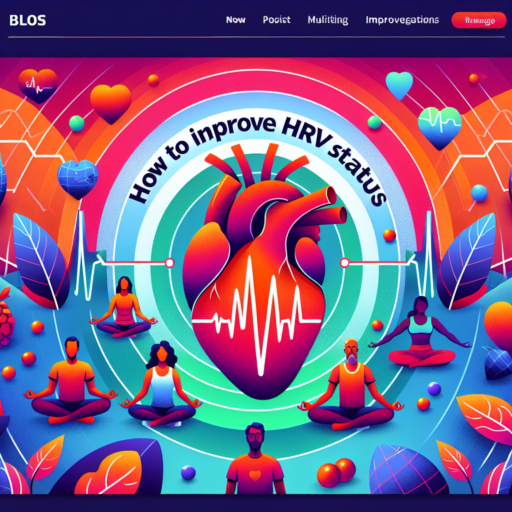No se han encontrado productos.
Can HRV be improved?
Many individuals are turning their attention towards Heart Rate Variability (HRV) as a metric to gauge their overall health and wellness. The intriguing question of whether HRV can be improved garners significant interest amongst health enthusiasts and professionals alike. Fortunately, the answer is positive. There are several methods backed by research that can help enhance one’s HRV, indicating better autonomic nervous system balance and stress resilience.
Lifestyle Changes for Better HRV
Making simple yet impactful lifestyle changes can significantly affect your HRV in a positive way. Engaging in routine physical activity, ensuring adequate sleep, and managing stress through mindfulness-based practices like meditation are paramount. Additionally, a balanced diet rich in omega-3 fatty acids has been shown to have a positive effect on HRV levels. These shifts in daily habits contribute not only to an improved HRV but also to a healthier life.
Techniques to Enhance HRV
Beyond lifestyle adjustments, specific techniques and practices can directly aim to improve one’s HRV. For instance, breathing exercises, particularly those that focus on diaphragmatic breathing, have been proven to enhance HRV by promoting relaxation and reducing stress levels. Similarly, adopting cold exposure through practices like cold showers or ice baths can also increment HRV, though it’s essential to approach such techniques cautiously and gradually.
Why is my HRV status so low?
Exploring the reasons behind a low Heart Rate Variability (HRV) can provide valuable insights into your overall wellbeing. Generally, a lower HRV indicates that your body is under stress, be it from physical exertion, emotional distress, or other health issues.
Stress and Anxiety: Persistent stress and anxiety are commonplace in our fast-paced world, significantly impacting HRV. When under stress, your body’s «fight or flight» response is activated more frequently, reducing HRV and signaling a lower resilience to stress. This interplay highlights the need for effective stress management techniques to improve HRV.
Lack of Sleep: Quality sleep is foundational for health, including optimal HRV. Insufficient or fragmented sleep can impair your body’s ability to recover, leading to a lowered HRV. Establishing a regular sleep routine and minimizing sleep disruptors are vital steps towards improving your HRV status.
Understanding the factors affecting your HRV is crucial in taking steps to improve it. Regular monitoring can help identify patterns and triggers, guiding you towards interventions that can positively impact your HRV and overall health.
What is a good HRV by age?
Understanding a good Heart Rate Variability (HRV) by age requires delving into how our cardiovascular system interacts with our nervous system. HRV refers to the variation in the time interval between heartbeats, and it’s an indicator of our autonomic nervous system’s efficiency and balance. Generally, a higher HRV is associated with better cardiovascular fitness, stress resilience, and overall health.
Children and Adolescents
Children and adolescents typically exhibit higher HRV figures due to their developing cardiovascular systems and higher metabolic rates. For this age group, HRV can range significantly, but average figures are usually between 55-100 milliseconds (ms). This wide range suggests a robust responsiveness to environmental stressors and a strong, adaptable cardiac system. It is important, however, to consider individual health conditions and lifestyle factors that may affect HRV.
Adults
As we age, our HRV naturally decreases. Adults in their 20s to mid-40s might expect their HRV to average between 40-60 ms. This age range is generally considered the peak period for maintaining a high HRV through regular physical activity, stress management, and a balanced diet. It’s also the stage where monitoring HRV can give crucial insights into one’s health trajectory and potential areas for improvement.
Older Adults
In older adults, those in their 50s and beyond, HRV often lowers further, with averages tending to fall in the range of 20-40 ms. At this stage, maintaining a good HRV becomes more challenging yet remains crucial for predicting cardiovascular health and longevity. Lifestyle adjustments, along with close monitoring of HRV, play a pivotal role in sustaining an acceptable HRV range and enhancing life quality.
Is 30ms a good heart rate variability?
Understanding the intricacies of Heart Rate Variability (HRV) is essential for anyone looking to optimize their health and fitness regimes. HRV refers to the variation in the time interval between heartbeats. It’s a widely recognized marker of autonomic nervous system (ANS) function and resilience. But when it comes to the numbers, especially a 30ms heart rate variability, interpreting its significance requires a closer look at individual health contexts and fitness goals.
Heart Rate Variability, measured in milliseconds (ms), reflects the body’s ability to adapt to stress, exercise, and disease. A reading of 30ms can be considered from multiple perspectives. For athletes or individuals with a high level of physical fitness, a HRV in this range might indicate a need for improved recovery strategies or an examination of potential overstress or overtraining situations. However, for a person just beginning their fitness journey or coming from a period of low physical activity, a 30ms HRV could represent an initial baseline to improve upon with targeted lifestyle changes and increased physical conditioning.
It’s also crucial to recognize that HRV is highly individualized. Factors such as age, gender, and overall health significantly influence what constitutes a «good» HRV. For one individual, a 30ms reading may fall within an optimal range, signaling a well-balanced autonomic nervous system. Meanwhile, for another, it might suggest room for improvement in stress management or physical health. Incorporating regular HRV tracking as part of a comprehensive health monitoring plan is recommended to understand personal baselines and track changes over time.




